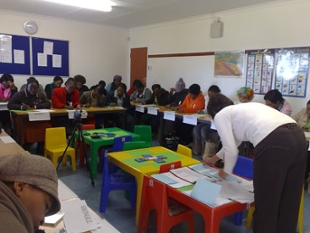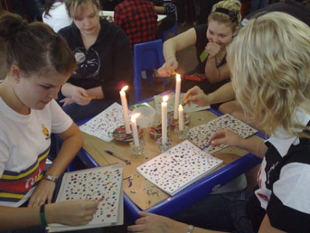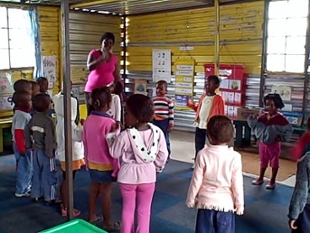Martha note: JMU's Public Affairs Coordinator, Eric Gorton, sent this out, and I found it so fascinating, I thought I'd just pass it along to you. This article appears also in Madison Scholar.
Dr. Teresa Harris, professor of early childhood education at JMU, was awarded a Fulbright Scholarship for spring semester 2010 to build collaboration between the university's early childhood/elementary education programs and the University of Pretoria Early Childhood Development Department.
 Dr. Ina Joubert, a lecturer at the University of Pretoria in early childhood education, prepares for a session with early childhood trainers.
Dr. Ina Joubert, a lecturer at the University of Pretoria in early childhood education, prepares for a session with early childhood trainers.  First-year early childhood education students at the University of Pretoria participate in an art workshop as part of their module on learning materials and resources in early childhood.
First-year early childhood education students at the University of Pretoria participate in an art workshop as part of their module on learning materials and resources in early childhood.  A teacher leads children in a song at a rural child care center that participates in the Ntataise child care training program.
A teacher leads children in a song at a rural child care center that participates in the Ntataise child care training program.Related Links
More photos from Dr. Harris' stay in South Africa.
Dr. Harris
wrote a blog while in South Africa.
What comes to mind when you think of 2010? Well, for South Africans, 2010 is synonymous with World Cup soccer. Preparations that were under way in 2006, the year I first visited the country, culminated with great fanfare as countries from around the world came to celebrate the world of soccer. The airport was updated with more parking and more services, highways were extended and expanded and security was enhanced. And best of all, Fulbright awarded me a six-month fellowship to teach at the University of Pretoria in the early childhood education department.
Education in post-apartheid South Africa continues to undergo major changes at every level. Issues related to infrastructure of schools, teacher education and professional development, and learner performance are regularly in the news and on the minds of all the stakeholders. From my position within early childhood, I was privileged to visit preschools and elementary schools, work with pre-service and in-service teachers and conduct research with colleagues at the university.
Preschool EducationFrom a grandmother's home to BMW-sponsored child care, preschool education and child care is available to many children. Like the United States, there are more informal than formal settings and the quality of care varies greatly. What seems to be consistent across rural and township settings, however, is the perception that because all women take care of the children, no one needs training or additional education to do it well. In fact, if you're going to study something at university, the belief is you should study something that will actually allow you to earn money and prestige. One exciting project that brings together early childhood teacher educators and child care providers in a rural setting is the
Ntataise Project (pronounced n-tata-ee-se).
Meaning "to lead a child by the hand," this nonprofit organization provides training to trainers who then go into rural areas to deliver workshops, materials and on-site supervision and modeling so that child care providers can gain skill in caring for and educating young children. While I was in South Africa, I traveled to visit the Ntataise headquarters and two local centers where teachers were adapting their training to their local contexts. On my second visit, UP lecturers Ina Joubert and Annalie Botha and I provided literacy training to the trainers in a full-day interactive workshop. On the second day of the training, the trainers incorporated our training ideas into their own training activities to show what they had learned and how they would adapt our session for their teachers.
Elementary EducationThe foundation phase of South African education includes the reception year (kindergarten) through grade 3 as part of primary schools that extend through grade 7. Since 1994, when the country moved to a democratic form of government, education has received increased government funding at all levels (primary through post-secondary); however, schools and their school governing boards can elect to charge school fees to increase their budgets. Former "Model C" schools typically charged the highest fees and continue today as multiracial schools that offer higher quality educational settings and opportunities than schools located in rural or township areas that can't afford to charge high fees to families. Sadly, it is clear in too many instances that you get what you pay for. In private schools and model C, or multiracial schools, teachers earn higher salaries, textbooks and teaching materials are up-to-date, buildings and facilities are well maintained and test scores are higher. In schools that receive basic government funding, the opposite is generally true. The major determinant, however, is not the funding, but the quality of school leadership, particularly in the person of the school principal.
On the day that I was moving into my flat, UP Lecturer Nkidi Phatudi, the colleague with whom I first established a relationship at UP, had taken me grocery shopping. We ran into one of the early childhood students who was doing her internship at a rural school. The young woman excitedly told Nkidi about the amazing principal who had all the teachers and learners motivated to be at school even though they didn't have all the fancy materials and equipment that other schools had. She went on to say that this was the school she hoped to work in when she graduated. Given the challenges of staffing schools in rural areas, this became an example of hope and began to spark some of the research that several of us are conducting.
Early Childhood Teacher EducationEarly Childhood (birth to age 5) and foundation phase (grades K-3) teacher education are built on a British model and reflect the best international practices in the field. My colleagues in the department are active scholars who are involved in the local schools and child care centers. They also work at the national level on early childhood policies and internationally in studies in STEM education and children's rights. For me, this experience was a wonderful opportunity to become immersed in scholarly activity that transcends geographic and cultural borders with people who are eager to work with members from the JMU College of Education.
Dr. Ina Joubert is currently examining questions related to children's understandings of citizenship. Extending the work of her dissertation, "South Africa is My Best Country," she is returning to local schools to longitudinally examine the development of children's concepts of citizenship. When I shared with her a research study, "Art Around the World," that is sponsored by the International Beliefs and Values Institute, we decided that there might be ways to work together to extend her primary grade study into the upper elementary grades using visual methodologies with the learners.
On a very different front, I was able to bring much of what I have learned through the Scholarship of Teaching and Learning workshops sponsored by the Center for Faculty Innovation at JMU to my work with Annalie Botha. Annalie uses role playing with her students and serves as faculty advisor to the TUKS Creative organization, so we began to explore the impact of fantasy play with children through her fairy project at the local malls and with her fourth-year and PGCE modules on curriculum integration.
Teacher identity has been the focus of work by Judy Van Heerden and Marie Botha as they instituted a teacher research project into the student teaching internship. We're doing a similar inquiry project with our department's fifth-year students, so we have decided to look at ways to collaborate on a series of developmental studies that examine our students' constructions of their own identities as teachers and their understandings of children as learners.
For a country that is primarily black South African, the students and faculty of my department were primarily white South African. I couldn't help but wonder why why this was the case, given the national and institutional supports for recruiting and retaining black students into teacher education. Dr. Miemsie Steyn, a lecturer in my department, had begun a study involving black students in the intermediate, secondary and further education phases (grades 8-12) to examine the barriers and assets to pursuing education as a career. Together we joined forces to take a look at why there were so few black students in the early childhood and foundation phase programs. Dr. Steyn will visit JMU in October to share our research.
Although my relationship with the early childhood education faculty began in 2006 with an e-mail to an unknown department head about the possibility of working together while my students and I were visiting South Africa, the Fulbright program provided an extended time period for a relationship to develop solid roots in this country. The JMU/UP collaboration has officially begun with many opportunities for shared scholarship and teaching. The 2011 visit to South Africa with students has entered the planning stages and we are exploring additional possibilities for faculty and student exchanges. And while 2010 World Cup fans are looking forward to Brazil, the UP and JMU folks are looking forward to an exciting time of working together.



























































